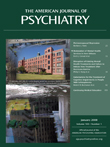Elevated Cardiac Risk in Patients With Major Depressive Disorder
To The Editor: In their most recent report of the Heart and Soul Study, published in the September 2007 issue of the Journal , Christian Otte, M.D., et al. documented an association between carriage of the s allele of the serotonin transporter polymorphism (5-HTTLPR) and elevated urinary norepinephrine levels (1) and, by inference, sympathetic nervous activation. This is an important observation and may explain the elevated cardiac risk in patients with major depressive disorder. Activation of the sympathetic outflow to the heart occurs in patients unexpectedly developing ventricular tachycardia and ventricular fibrillation (2) . Chronic sympathetic nervous activation may exert a trophic effect on cardiovascular growth, contributing to the development of left ventricular hypertrophy (3) , which is an independent risk factor for cardiovascular morbidity and mortality (4) . Unfortunately, Dr. Otte et al. did not document the presence or absence of left ventricular hypertrophy in their cohort (1) .
It is important to appreciate that human sympathetic nervous activity is regionalized, with the outflow to some organs, such as the heart, sometimes being preferentially activated. Indeed, preferential activation of the cardiac sympathetic outflow occurs with experimental mental stress (5) . Urinary norepinephrine levels provide, at best, an imprecise index of global sympathetic nervous function. Using direct cardiac catheterization techniques coupled with norepinephrine isotope dilution methodology, we have recently demonstrated that sympathetic activity in patients with major depressive disorder follows a bimodal distribution, with values in some patients being extraordinarily high (6) . The degree of cardiac sympathetic activity in the “high” major depressive disorder group was comparable with that observed in subjects following laboratory mental stress (5) . Following selective serotonin reuptake inhibitor therapy, sympathetic nervous activity was significantly reduced only in those patients with excessively elevated sympathetic tone. Whether the bimodality in sympathetic activity in major depressive disorder that we observed was associated with the s or l allele of the 5-HTTLPR remains unknown but obviously merits attention.
1. Otte C, McCaffrey J, Ali S, Whooley MA: Association of serotonin transporter polymorphism (5-HTTLPR) with depression, perceived stress, and norepinephrine in patients with coronary disease: the Heart and Soul Study. Am J Psych 2007; 164:1379–1384Google Scholar
2. Meredith IT, Broughton A, Jennings GL, Esler MD: Evidence of a selective increase in cardiac sympathetic activity in patients with sustained ventricular arrhythmias. N Engl J Med 1991; 325:618–624Google Scholar
3. Schlaich MP, Kaye DM, Lambert E, Sommerville M, Socratous F, Esler MD: Relation between cardiac sympathetic activity and hypertensive left ventricular hypertrophy. Circulation 2003; 108:560–565Google Scholar
4. Levy D, Garrison RJ, Savage DD, Kannel WB, Castelli WP: Prognostic implications of echocardiographically determined left ventricular mass in the Framingham Heart Study. N Engl J Med 1990; 322:1561–1566Google Scholar
5. Esler M, Jennings G, Lambert G: Measurement of overall and cardiac norepinephrine release into plasma during cognitive challenge. Psychoneuroendocrinology 1989; 14:477–481Google Scholar
6. Barton DA, Dawood T, Lambert EA, Esler MD, Haikerwal D, Brenchley C, Socratous F, Kaye DM, Schlaich MP, Hickie I, Lambert GW: Sympathetic activity in major depressive disorder: identifying those at increased cardiac risk? J Hypertens 2007; 25:2117–2124Google Scholar



